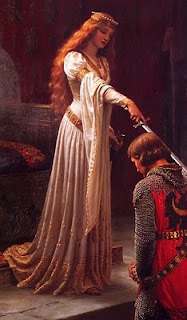Diffuse light sources are the most common and useful lights in painting. They make great fill lights, rim lights, and key lights, they always make subjects look appealing. They tend to soften features and are good for creating a pensive emotional response when used as key lights. Light reflected from "lambert surfaces" always fits into this category.
I didn't have time to paint examples and the great masters are better at it, so instead here's Edmund Blair Leighton above, using a bright overcast sky to support the gentleness of the scene. William Bouguereau's painting below that uses the common "north light" from a window to soften the girl's features and emphasize her beauty.
Direct or spot lights have a strong visual impact and are useful for creating drama or tension. You can mix the effects of direct light sources with the effect of diffuse light sources by using light sources that are somewhere in between. Here's a great example from Paul Delaroche of the drama created by a direct light source. Below that, Edmund Blair Leighton shows how a diffuse light can have some of the dramatic effect of a direct light, in this case by using a large window but positioning it some distance behind the subject.
Remember that spot lights are really just direct sources with something "off camera" casting a shadow, so the light beam has a specific shape to it. This shape doesn't always have a hard edge, a great example being sunlight blocked by soft-edged clouds (see Albert Bierstadt example below, on the rocks). So you can also mix the softening effects and gradients you'd get from a diffuse source with the hard shadows of a direct source.
Finally, nearby light sources are the most dramatic of all, but they can also be distracting if too strong or used too often, because of the visual tension they create. I also forgot to explain another thing about them on the other site, so I'll post it here instead.













posts like these are incredibly well explained and helpful. can't wait for the book!
ReplyDeleteExcellent post. I also look forward to the book. I'm unofficially pre-ordering it riiiight now.
ReplyDeleteso as a rule of thumb, you would want to use a diffused light source for a more serene scene, and focused light sources for tension and drama? I'm having a hard time understanding when to use different light scenarios
ReplyDeleteVery cool. I look forward to the book Sam!
ReplyDeleteI feel like I should be paying you cause this is way more than I was taught in school. sad but true
ReplyDeletevery nice tips and examples.
ReplyDeletewww.denisfeliz.blogspot.com
www.denisfeliz.com.br
GodDamn, Sam, amazing helpful post. This is totally helping me, man, thanks a million. Ad I'm still waiting for the blasted book!!! =D
ReplyDeleteSam, do you plan on your book being available across the pond?
ReplyDeleteLike Stefan above, put me down for an pre-order! Cheers!
What's interesting is when you use the direct light, but place it at an unexpected angle - the Rembrandt portrait lighting that leaves a distinct triangle on the off cheek of the subject. When I shot portraits, I liked to us a more diffuse source, but strong enough to achieve the same triangle, but with dithering edges.
ReplyDeleteYour blog is fantastic!
ReplyDeleteKeep creative and instructive!
Hey Sam. I've been visiting your blog for just two week but I'm so impressed by your work and knowledge. Your an huge inspiration to me. Thank you for sharing your knowledge with us. I hope I can improve with your tips.
ReplyDeleteSam... I need that book!! Thanks so much for the incredibly helpful posts. There is just sooo much to think about when painting and you really clarify and simplify fabulously.
ReplyDeleteTHANKS
Amazing work Sam.
ReplyDeleteReally love reading your blog. I have just recently found it while surfing. I work with a lot of young artists and we don't have much in terms of mentors. Blogs like this really make a difference for us...so TY.
ReplyDeleteHi Sam,
ReplyDeleteI've been going through your blog and it's great to read your thoughts and see your older work compared with your newer work. It's inspiring.
Whenever you publish that book I'm going to buy it and tell every artist and aspiring artist I know to pick it up. And thanks again for keeping up your blog!
Cheers,
Mike
thanks for the tutooo! benja
ReplyDeletevery helpful post!
ReplyDeleteI also might add a word about sunlight and the problem with it :
The sun is greater than the earth and therefore cast shadows that are always parallel.
While lightbulbs or smaller lightsources do fit the description with your example of "nearby sources"
I thought this is important to mention;-)
Thanks for the comments everyone! I'll try to be better at responding to comments when I get a little less busy.
ReplyDeleteWhen do you expect the book release?
ReplyDeletehey good job
ReplyDeleteExcellent post..Its really interesting about shadow..keep posting such interesting pictures..
ReplyDeleteExcellent Post! Picture Lighting
ReplyDelete